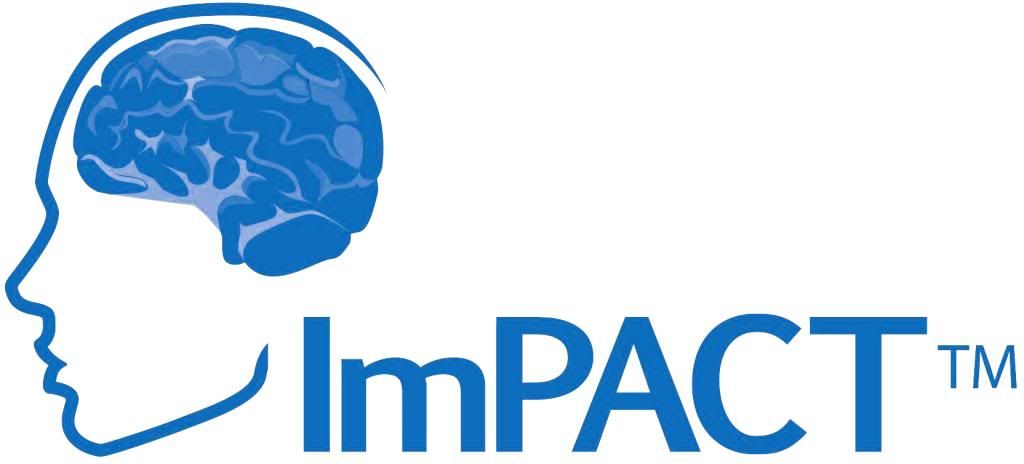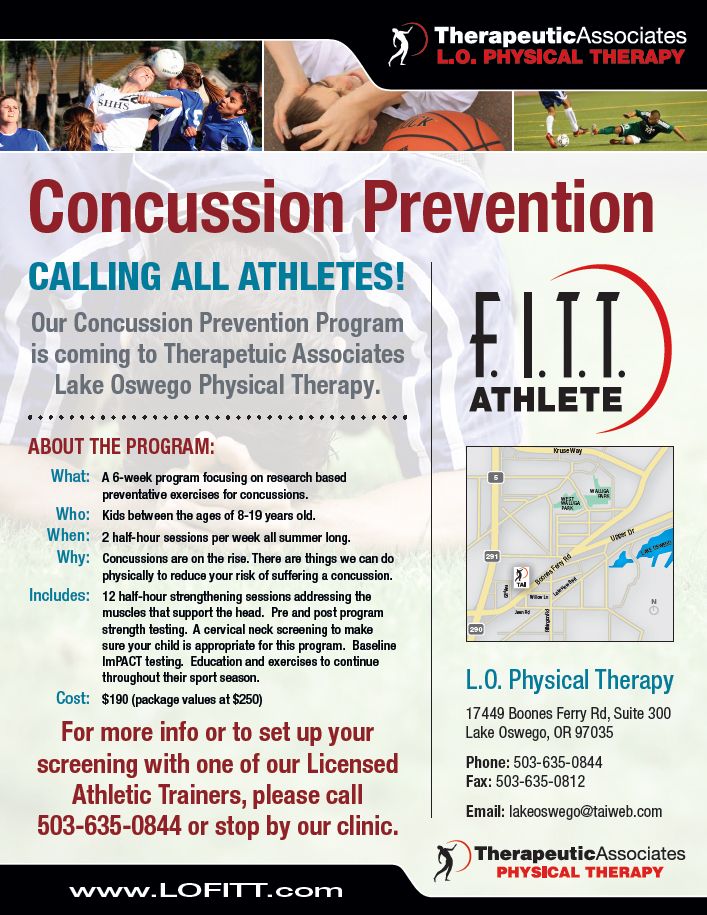 |
May 2013 E-Newsletter

|
 |
 |
The Truth About Concussions
|
 |
 |

There has been a lot of media attention and concern about concussions with sports so we have devoted this month’s newsletter to help inform the people we care about (you!), about this
important and sensitive topic. It is important to understand what concussions are, how to identify them, how to treat them, and how to prevent them. We also want you to know that we have been working on one of the most compressive concussion management programs in Oregon for the past six months and will be available in the next couple months. Our team of physical therapists, athletic trainers, cognitive therapist, dietitian, and trainers will be working with local physicians and scientists to provide complete comprehensive concussion management that is accessible and thorough. We are working with Oregon experts in concussions as well as medical groups from Canada, Kansas, and Philadelphia to ensure the highest level of care and safety possible for the Portland community. We will be revamping our website to provide more information and additional information will be sent
out as our program evolves.
- Shawn Dailey PT, DPT, Clinic Director
Here is some information from current research to help dispel some myths:
Definition of Concussion
A concussion is a form of mild Traumatic Brain Injury defined as a complex pathophysiological process affecting the brain which is induced by biomechanical forces. Basically it is a closed head injury to the brain from jarring/shaking/hitting the head and/or neck/body that effects how the brain functions.
Effects of a Concussion
The effects are as complicated as the brain because they depend on which part of the brain is injured, but the most common symptoms are: headache, nausea, tired/sleepy, sensitivity to light or noise, trouble concentrating, feeling foggy, memory difficulties, dizzy, feeling sad / anxious / depressed / angry / nervous / impulsive, not acting “normal” and hard to process information. If you (parent/coach) have any question or suspicion of a concussion or notice any of these signs/symptoms, pull the kid out of the game/event and do not let them participate again until they have been checked by a medical professional!!!
The most common reported symptom is headache which is also the least reliable because there can be several causes of a headache. Physical Therapists are experts in the neck and spine so it is important to see a PT to determine if there is a neck injury and if it is contributing to the individual’s symptoms. If there is a concussion I only recommend seeing a PT who is well versed in concussion management and has a detailed program for concussions.
Length of Injury
Concussion symptoms and effects very greatly so it is extremely important to treat each one individually! In general, about 80% of symptoms resolve within 10 days and 90% in three weeks, but 10-20% can take several months to recover.
Causes of Concussions
Top 4 Causes of concussions for persons under the age of 18: Falls, Sports, Bike Accidents, and Motor Vehicle Accidents.
I feel it is important to focus on preventing and proper treatment/management of concussions instead of pointing fingers at sports so we can help our kids be safe/healthy.
Top 10 Concussions Rates in Sports
Football, Soccer, Hockey, Lacrosse, Wrestling, Basketball, Baseball, Cheerleading, Softball, gymnastics.
Treatment/Management
It is important for the person to rest both physically and cognitively and see a medical professional ASAP. There are important steps to recovery and we feel it is important to utilize a program that will help guide the parent and student through the course of recovery and involves a multi-disciplinary team with a medical doctor. Having a guided Return to School Plan & Return to Play Plan (or Return to Work Plan) is essential for the safety and success of individual!!! It is an Oregon State Law that only a qualified medical professional can clear a person to return to playing sports after a concussion.
Prevention
There are many ways to prevent the rate and severity of concussions as well as their effects to an individual. Many of these methods are sport specific and are as simple as using proper fitting equipment, have a well thought-out practice structure, coach/parent education, proper cervical strengthening program, proper warm up, and creating safe sports drills.
The most important way to keep our kids safe is to have a concussion prevention and management plan for your team, identify a concussion early, manage it properly with a trained medical team/provider, and make sure they are fully healed and safe to play before returning to activities.
For more information on this topic or our program please feel free to email us at lakeoswego@taiweb.com. Additional resources that are easy to understand and provide valuable information on concussions:
CDC :: Concussion in Sports
MomsTeam :: Concussion Signs and Symptoms
ImPACT :: Concussion Management
|
 |
 |
 

|
 |
|
 |
Certified Athletic Trainers :: A Valuable Resource for Concussions
|
 |
 |

Certified Athletic Trainers are a valuable resource in the medical team that help with the prevention, diagnoses and recovery of concussions. Physicians are present at a
relatively small percentage of high school practices and contests. Thus, the initial evaluation and management often is completed by an athletic trainer. The AT often has daily interaction and the opportunity to establish a trusting relationship with the athletes so it is important for Coaches, Physical Therapists, and Physicians to work with ATCs in the management of athletes who have sustained a concussion.

Obtaining baseline scores on a series of cognitive and postural stability tests is paramount, considering that, unlike orthopedic injuries, there is no contralateral limb to use for comparison. ImPACT provides computerized neurocognitive assessment tools and services that are utilized to assist them in determining an athlete's ability to return to play after suffering a concussion. Using the results compared to the athlete’s baseline test, we can determine their neurocognitive status, and make an educated decision on their ability to return to competition. The methods used for returning the athlete to participation are similar to those
employed by ATs in deciding when to return an athlete after suffering a musculoskeletal injury. A window of protection is followed by successive performance-based criteria that, when achieved, advance the athlete to the next level of participation.
SUMMER NECK STRENGTHENING FOR CONCUSSION PREVENTION :: CLICK HERE TO DOWNLOAD OUR FLYER (PDF)

|
 |
 |
 

|
 |
|
 |
The Hidden Affects of a Concussion on the Brain
|
 |
 |

Most often, the focus with a concussion is the area of the brain where the impact occurred. However, there is another aspect that causes the majority of the issues of cognitive function after getting a concussion. Bi-lateral Integration Interruption, often gets over looked or is unknown, and if overlooked can have future devastating affects on the person.
The brain is divided into two halves, the right and left hemisphere, these two hemispheres are connected by the Corpus Callosum, a very thick bundle of nerve fibers (over a trillion billion) whose primary function is the transfer of information between the two halves of the brain. Much like the city of Portland has an east side and a west side, and is divided by the Willamette River, we have bridges connecting both sides with fairly decent traffic flow (Don’t laugh). Now imagine an earthquake taking out all the bridges except one. How would your morning commute be then? A concussion is like an earthquake in the brain taking out or damaging the corpus callosum (bridges) so the brain can not have an efficient flow of information. This flow of information constitutes most all our cognitive and physical abilities. If we are not processing such things like concentration, spatial
recognition, balance or reaction time efficiently we have an increased chance for additional concussions, or even physical injuries in the future. Time is not enough to correct these issues, it takes a very specific targeted cognitive therapy.
Synergy Training Center Brain Performance and Care can help you get back to your preconcussion, athletic abilities to play efficient and safe.
“Success in sports is the direct result of how well your mind channels all your physical talents.”
- Darren Painter
Synergy Training Center Brain Performance and Care
17449 Boones Ferry Rd, Suite 300
Lake Oswego, OR 97035
Phone: 503-597-2088
www.synergytrainingcenter.com
|
 |
 |
 

|
 |
|
 |
Concussions and Nutrition
|
 |
 |

Concussions, which are classified as mild traumatic brain injuries, account for 75% of the traumatic brain injuries (TBI) that occur both in military and civilian populations(4). The most
concrete nutrition recommendation for improving outcomes from TBI’s is early feeding, within 24-48 hours. Individuals should receive >50% of their energy expenditure within the 48 hours and 1-1.5 grams/kg of body weight/day of protein(2,4). Diets high in saturated fat and refined sugar may worsen outcome from brain injury. Nutrients that have been examined to potentially help are those aimed at reducing oxidative stress and inflammation. These nutrients include: omega 3 fish oil, vitamins A, C, D, E and B vitamins along with minerals selenium and zinc(3,4). For example, research in animals show 10-40 mg/kg/day of DHA is significant to improve damage after a TBI(1). The bottom line: more research, especially in humans, is needed to determine what, if any, level of these nutrients is needed to be beneficial after a concussion. A safe bet is to
quickly resume eating a healthy, balanced diet (low in saturated fat and refined sugar) with adequate protein while including foods high in omega-3 fatty acids such as fish, flaxseed, canola oil and walnuts.
- Bailey, JE. & Mills, JD. (2011). Docosahexaenoic acid reduces traumatic axonal injury in a rodent head injury model. Journal of Neurosurgery , 114(1), 77-84. doi: 10.3171/2010.5.JNS08914
- Cook, AM., Peppard, A. & Magnuson, B. (2008-2009). Nutrition Considerations in Traumatic Brain Injury. Nutrition in Clinical Practice. 23(6):608-20. doi: 10.1177/0884533608326060
- Gomez-Pinilla, F. (2008) Brain foods: the effects of nutrients on brain function. Nature Reviews Neuroscience, 9(7):568-78. doi: 10.1038/nrn2421
- Consensus Report from the IOM: Nutrition and Traumatic Brain Injury: Improving Acute and Subacute Health Outcomes in Military Personnel, Released: April 20, 2011
|
 |
 |
 

|
 |
|
|

